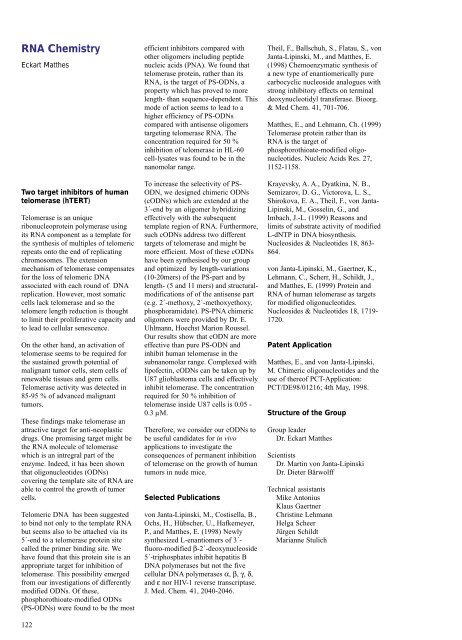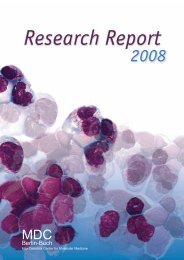Create successful ePaper yourself
Turn your PDF publications into a flip-book with our unique Google optimized e-Paper software.
RNA Chemistry<br />
Eckart Matthes<br />
Two target inhibitors of human<br />
telomerase (hTERT)<br />
Telomerase is an unique<br />
ribonucleoprotein polymerase using<br />
its RNA component as a template for<br />
the synthesis of multiples of telomeric<br />
repeats onto the end of replicating<br />
chromosomes. The extension<br />
mechanism of telomerase compensates<br />
for the loss of telomeric DNA<br />
associated with each round of DNA<br />
replication. However, most somatic<br />
cells lack telomerase and so the<br />
telomere length reduction is thought<br />
to limit their proliferative capacity and<br />
to lead to cellular senescence.<br />
On the other hand, an activation of<br />
telomerase seems to be required for<br />
the sustained growth potential of<br />
malignant tumor cells, stem cells of<br />
renewable tissues and germ cells.<br />
Telomerase activity was detected in<br />
85-95 % of advanced malignant<br />
tumors.<br />
These findings make telomerase an<br />
attractive target for anti-neoplastic<br />
drugs. One promising target might be<br />
the RNA molecule of telomerase<br />
which is an intregral part of the<br />
enzyme. Indeed, it has been shown<br />
that oligonucleotides (ODNs)<br />
covering the template site of RNA are<br />
able to control the growth of tumor<br />
cells.<br />
Telomeric DNA has been suggested<br />
to bind not only to the template RNA<br />
but seems also to be attached via its<br />
5´-end to a telomerase protein site<br />
called the primer binding site. We<br />
have found that this protein site is an<br />
appropriate target for inhibition of<br />
telomerase. This possibility emerged<br />
from our investigations of differently<br />
modified ODNs. Of these,<br />
phosphorothioate-modified ODNs<br />
(PS-ODNs) were found to be the most<br />
122<br />
efficient inhibitors compared with<br />
other oligomers including peptide<br />
nucleic acids (PNA). We found that<br />
telomerase protein, rather than its<br />
RNA, is the target of PS-ODNs, a<br />
property which has proved to more<br />
length- than sequence-dependent. This<br />
mode of action seems to lead to a<br />
higher efficiency of PS-ODNs<br />
compared with antisense oligomers<br />
targeting telomerase RNA. The<br />
concentration required for 50 %<br />
inhibition of telomerase in HL-60<br />
cell-lysates was found to be in the<br />
nanomolar range.<br />
To increase the selectivity of PS-<br />
ODN, we designed chimeric ODNs<br />
(cODNs) which are extended at the<br />
3´-end by an oligomer hybridizing<br />
effectively with the subsequent<br />
template region of RNA. Furthermore,<br />
such cODNs address two different<br />
targets of telomerase and might be<br />
more efficient. Most of these cODNs<br />
have been synthesised by our group<br />
and optimized by length-variations<br />
(10-20mers) of the PS-part and by<br />
length- (5 and 11 mers) and structuralmodifications<br />
of of the antisense part<br />
(e.g. 2´-methoxy, 2´-methoxyethoxy,<br />
phosphoramidate). PS-PNA chimeric<br />
oligomers were provided by Dr. E.<br />
Uhlmann, Hoechst Marion Roussel.<br />
Our results show that cODN are more<br />
effective than pure PS-ODN and<br />
inhibit human telomerase in the<br />
subnanomolar range. Complexed with<br />
lipofectin, cODNs can be taken up by<br />
U87 glioblastoma cells and effectively<br />
inhibit telomerase. The concentration<br />
required for 50 % inhibition of<br />
telomerase inside U87 cells is 0.05 -<br />
0.3 µM.<br />
Therefore, we consider our cODNs to<br />
be useful candidates for in vivo<br />
applications to investigate the<br />
consequences of permanent inhibition<br />
of telomerase on the growth of human<br />
tumors in nude mice.<br />
Selected Publications<br />
von Janta-Lipinski, M., Costisella, B.,<br />
Ochs, H., Hübscher, U., Hafkemeyer,<br />
P., and Matthes, E. (1998) Newly<br />
synthesized L-enantiomers of 3´fluoro-modified<br />
β-2´-deoxynucleoside<br />
5´-triphosphates inhibit hepatitis B<br />
DNA polymerases but not the five<br />
cellular DNA polymerases α, β, γ, δ,<br />
and ε nor HIV-1 reverse transcriptase.<br />
J. Med. Chem. 41, 2040-2046.<br />
Theil, F., Ballschuh, S., Flatau, S., von<br />
Janta-Lipinski, M., and Matthes, E.<br />
(1998) Chemoenzymatic synthesis of<br />
a new type of enantiomerically pure<br />
carbocyclic nucleoside analogues with<br />
strong inhibitory effects on terminal<br />
deoxynucleotidyl transferase. Bioorg.<br />
& Med Chem. 41, 701-706.<br />
Matthes, E., and Lehmann, Ch. (1999)<br />
Telomerase protein rather than its<br />
RNA is the target of<br />
phosphorothioate-modified oligonucleotides.<br />
Nucleic Acids Res. 27,<br />
1152-1158.<br />
Krayevsky, A. A., Dyatkina, N. B.,<br />
Semizarov, D. G., Victorova, L. S.,<br />
Shirokova, E. A., Theil, F., von Janta-<br />
Lipinski, M., Gosselin, G., and<br />
Imbach, J.-L. (1999) Reasons and<br />
limits of substrate activity of modified<br />
L-dNTP in DNA biosynthesis.<br />
Nucleosides & Nucleotides 18, 863-<br />
864.<br />
von Janta-Lipinski, M., Gaertner, K.,<br />
Lehmann, C., Scherr, H., Schildt, J.,<br />
and Matthes, E. (1999) Protein and<br />
RNA of human telomerase as targets<br />
for modified oligonucleotides.<br />
Nucleosides & Nucleotides 18, 1719-<br />
1720.<br />
Patent Application<br />
Matthes, E., and von Janta-Lipinski,<br />
M. Chimeric oligonucleotides and the<br />
use of thereof PCT-Application:<br />
PCT/DE98/01216; 4th May, 1998.<br />
Structure of the Group<br />
Group leader<br />
Dr. Eckart Matthes<br />
Scientists<br />
Dr. Martin von Janta-Lipinski<br />
Dr. Dieter Bärwolff<br />
Technical assistants<br />
Mike Antonius<br />
Klaus Gaertner<br />
Christine Lehmann<br />
Helga Scheer<br />
Jürgen Schildt<br />
Marianne Stulich

















